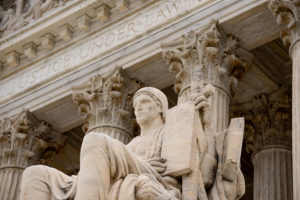
Challenges to redistricting are unlikely to be successful after recent Supreme Court decisions.
It looks like federal courts will not be slowing down partisan gerrymandering any time soon.
Despite much suspense about whether the U.S. Supreme Court would finally act against the worsening problem of gerrymandering, the Court refused to do so again this past term in Gill v. Whitford and Benisek v. Lamone. The Court largely avoided decisions on the merits in those two cases, leaving the law in the same state of confusion that has long existed.
Now that retiring Justice Anthony M. Kennedy could be replaced by the more conservative Brett M. Kavanaugh, who will likely be more hostile to judicial oversight of the political process, the Court’s refusal to act signals an end to any new constitutional restraints on partisan gerrymandering.
The opportunity for gerrymandering arises in the first place because, when political representatives are elected from geographic districts, the government must redraw those districts from time to time to account for population change. In most democracies, independent commissions undertake this responsibility. But in the United States, we largely allow elected officials to decide district lines for themselves and their colleagues.
The obvious problem is that elected officials who decide district lines can rig them to help themselves and their friends. Politicians in charge of redistricting can place enough friendly voters in their own districts to ensure re-election of themselves and their party, while endangering the opposing party by wasting the other party’s votes.
Gerrymandering encompasses “packing” within districts—when voters of one party are concentrated in a supermajority inside a single district—and “cracking” across districts—when voters of one party are splintered across many districts. To be sure, packing and cracking require sophisticated engineering, but, by these means, gerrymandering enables politicians to pick their voters instead of the voters picking their politicians.
Courts nonetheless have been reluctant to restrict political gerrymandering.
Fourteen years ago, in Vieth v. Jubelirer, the Supreme Court appeared poised to instruct lower courts to strike down the worst instances of political gerrymandering in a constitutional challenge to a Republican redistricting of Pennsylvania’s state legislature. Astoundingly, however, the justices so disagreed that they did not decide a standard for judging redistricting, resulting in a fractured decision without a majority opinion.
Central to the mess was Justice Kennedy, who held the pivotal vote in the case as usual. He decided that the Court should not “bar all future claims of injury from a partisan gerrymander” because the absence of a standard today “should not be taken to prove none will emerge in the future.” Justice Kennedy suggested that the “First Amendment may be the more relevant constitutional provision in future cases.” Understandably, no one knew exactly what to make of this confused result, without a majority opinion or a clear standard from Justice Kennedy’s concurrence.
The next decade brought no progress or court victories for gerrymandered plaintiffs across the country, with the Supreme Court itself—in a decision by Justice Kennedy—dismissing a partisan gerrymandering claim from Texas in LULAC v. Perry.
But finally, in late 2016, a group of Democratic plaintiffs in Wisconsin broke through with the first successful constitutional challenge against a partisan gerrymander. Wisconsin Republicans had gerrymandered state legislative districts so that they won just 48.6 percent of the two-party vote, but still won 60 of 99 assembly seats in 2012.
Applying a measure of a gerrymander’s partisan bias called the “efficiency gap,” the plaintiffs convinced the trial court that the Republican gerrymander violated the Equal Protection Clause of the U.S. Constitution’s Fourteenth Amendment.
Around the same time, Republican plaintiffs in Maryland challenged a congressional district gerrymandered to swing from longtime Republican to Democratic control. The plaintiffs sued under the First Amendment, rather than the more familiar equal protection grounds, which seemed calculated to win Justice Kennedy’s swing vote.
Both these cases, Gill v. Whitford and Benisek v. Lamone, soon ended up on the Supreme Court’s docket. Opponents of gerrymandering might have believed the growing severity of gerrymandering under modern hyperpartisanship would ultimately motivate the justices to act. Justice Kennedy had held the door open to judicial oversight but seemed unsure exactly how courts should intervene.
The Court’s decisions in Gill and Benisek, however, dashed hopes that federal courts would finally intervene against gerrymandering. Neither the introduction of the efficiency gap measure in Gill nor the invocation of the First Amendment in Benisek, which Justice Kennedy earlier invited, made a difference. Last month, Justice Kennedy quietly voted with the majority in both cases to dismiss the plaintiffs’ claims, albeit on technical grounds.
Now that Justice Kennedy announced his retirement shortly after the decisions in these cases, partisan gerrymandering claims will almost certainly not succeed with the Supreme Court for quite a while. The remaining four Republican appointees are hostile to judicial oversight of the political process and will presumably be joined by a new Trump appointee who shares their hostility.
Even aside from personnel change on the Court, it still would be very difficult for gerrymandering plaintiffs to succeed following Gill. In Gill, the Court held that gerrymandering challenges must be brought on a district-specific basis rather than a statewide basis. Individual plaintiffs now need to establish that they were unconstitutionally harmed by the boundaries of their respective districts, regardless whether their political interests are harmed more generally by a statewide gerrymander.
This requirement of district-specific showings adds a new complication beyond showing overall statewide partisan bias. Finding plaintiffs from each challenged district is not difficult, but the district-specific proof of partisan intent and its effect likely will be. The greater burdens for plaintiffs in these cases increasingly resemble those from the racial gerrymandering cases of the 1990s. In those cases, plaintiffs and courts struggled to identify district-specific legislative intentions and to distinguish clearly between partisan, racial, and other types of motivations even when they could.
Justice Elena Kagan’s concurrence in Gill attempted to draw out a roadmap for how to handle these gerrymandering challenges on a district-specific basis through examination of whether packing or cracking affected their voting. And there are so-called “pinpoint redistrictings,” involving a single or handful of districts reconfigured mid-decade nakedly for partisan purposes that would suit this analytic framework quite well.
But the analytical challenges and exacerbated problems of proof after Gill provide the conservative Justices firmer grounds for dismissing judicial intervention as too complicated and subjective. It is easy now to foresee that the Court will sooner close the door altogether on gerrymandering claims than provide any new constitutional restraints on partisan gerrymandering in the future.
This essay is part of a series, entitled The Supreme Court’s 2017–2018 Regulatory Term.




